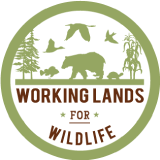Fact Sheets
Environmental Flow Analysis for the Marcellus Shale Region PDF
A technical report submitted to the Appalachian Landscape Conservation Cooperative in completion of grant# 2012-03 - Final Report
Identifying Species in Pennsylvania Potentially Vulnerable to Climate Change
This report provides the methods and results of 85 species vulnerability assessments in Pennsylvania.
Vulnerability of at-risk species to climate change in New York
This report provides the methods and results of climate change vulnerability assessments of 119 species in New York.
Fact Sheet - Science Products from the North Atlantic LCC
Fact Sheet providing examples of Science Products from the North Atlantic LCC with links
Fact Sheet - The North Atlantic LCC in the Chesapeake Bay Watershed
Fact Sheet providing examples of products and partnerships associated with the North Atlantic LCC in the Chesapeake Bay Watershed with links
Awareness and Outreach
The information and tools from this research is intended to inform planning decisions that can effectively avoid, minimize, or offset impacts from energy development to important natural areas.
Fact Sheet: Assessing Future Energy Development Managers Guide
Provides a general overview of the need for the Energy Assessment research, the major products and findings that came out of the project, and the relevance of the study, models, and tools to the resource management community.
Shale Gas, Wind and Water: Assessing the Potential Cumulative Impacts of Energy Development on Ecosystem Services within the Marcellus Play
A Nature Conservancy study funded by the Robertson Foundation and published by the open-access Public Library of Science (PLoS) in January 2014, assessed potential impacts of future energy development on water resources in the Marcellus play region.
Assessing Future Energy Development across the Appalachian LCC. Final Report
In this study funded by the Appalachian LCC, The Nature Conservancy assessed current and future energy development across the entire region. The research combined multiple layers of data on energy development trends and important natural resource and ecosystem services to give a comprehensive picture of what future energy development could look like in the Appalachians. It also shows where likely energy development areas will intersect with other significant values like intact forests, important streams, and vital ecological services such as drinking water supplies.
Central Hardwoods Joint Venture Glade Conservation Assessment For the Interior Highlands and Interior Low Plateaus Of the Central Hardwoods Region
The glade conservation assessment is a collaborative effort among 8 states to document the current status and distribution of 24 distinct glade ecosystems and their associated species of conservation concern within the Central Hardwoods Bird Conservation Region, as well as the Ouachita Mountains to the south.
Fact Sheet: Riparian Restoration Decision Support Tool
An innovative web-based tool - funded by the Appalachian Landscape Conservation Cooperative (LCC) and developed by researchers from the U.S. Forest Service and the University of Massachusetts - is allowing managers to rapidly identify high-priority riparian targets for restoration to make more resilient in preparation for changes in future climate. The Riparian Restoration Prioritization to Promote Climate Change Resilience (RPCCR) tool identifies vulnerable stream and riverbanks that lack tree cover and shade in coldwater stream habitats. By locating the best spots to plant trees in riparian zones, resource managers can provide shade that limits the amount of solar radiation heating the water and reduces the impacts from climate change. This well-established management strategy will benefit high-elevation, cold-water aquatic communities.
National Fish, Wildlife, & Plants Climate Adaptation Strategy
The purpose of the National Fish, Wildlife and Plants Climate Adaptation Strategy is to inspire and enable natural resource administrators, elected officials, and other decision makers to take action to adapt to a changing climate. Adaptation actions are vital to sustaining the nation’s ecosystems and natural resources — as well as the human uses and values that the natural world provides.

























